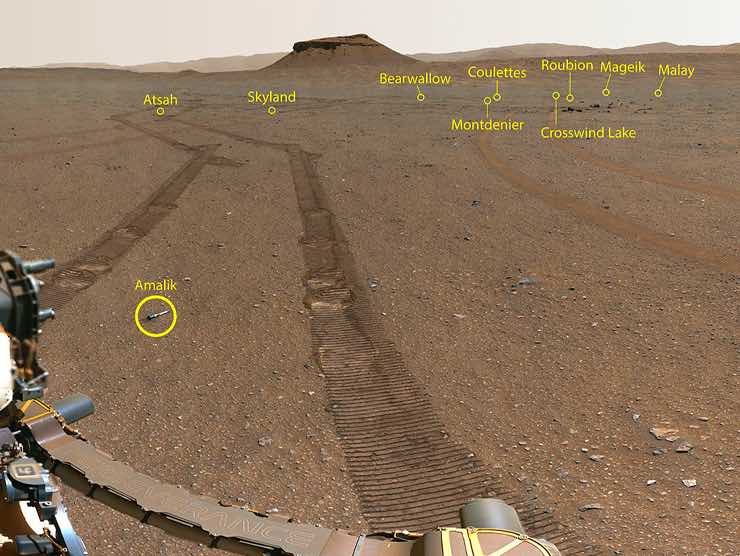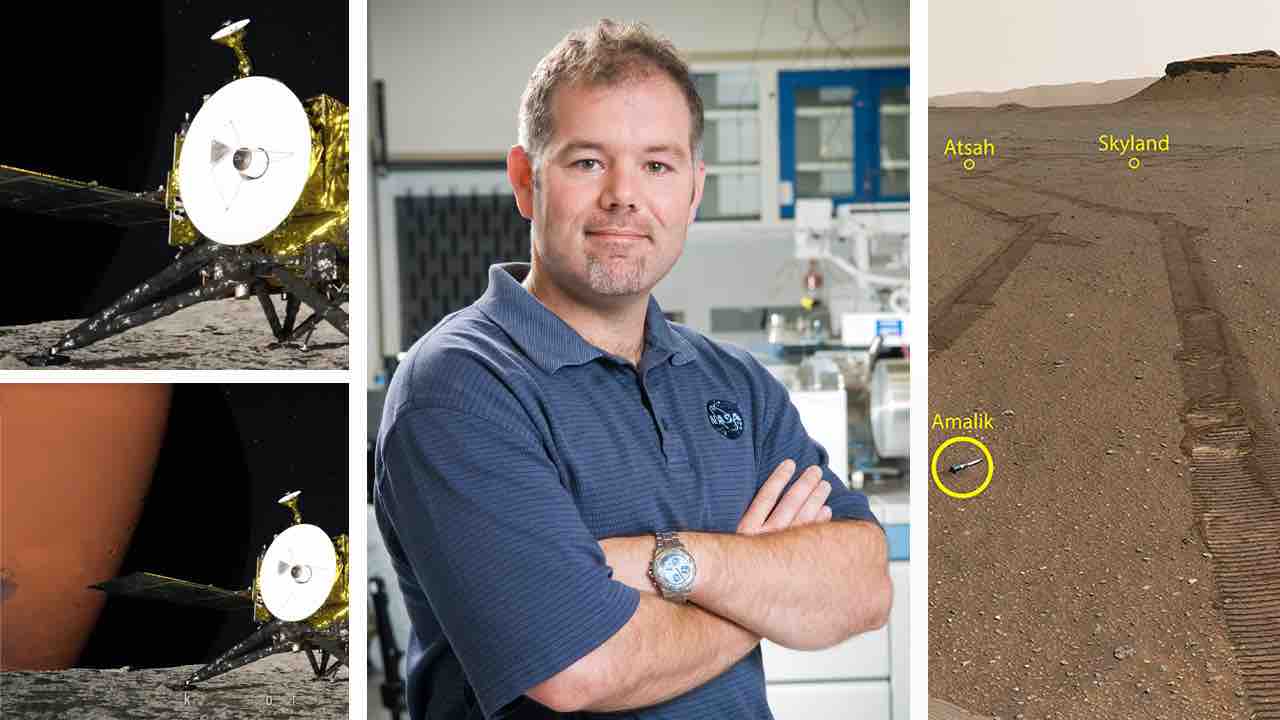We met Daniel P. Glavin, Astrobiologist at NASA Goddard Space Flight Center in Greenbelt, Maryland (USA). He looks for the building blocks of life in extraterrestrial materials, including meteorites, asteroids, comets and other interplanetary dust particles. Glavin is the Senior Scientist for Mars Sample Return (MSR) in the Solar System Exploration Division at NASA Goddard. Then, he has been selected by NASA to conduct laboratory analyzes on Phobos samples, which will be brought to Earth by JAXA’s Martian Moons eXploration (MMX) mission.
The NASA/ESA Mars Sample Return mission has the task of fetching the Mars samples that the Perseverance rover is collecting on Mars and, through a lander, a small rocket and an orbiter, will bring them to Earth by 2033. The JAXA’s MMX mission, however, will be launched in 2024 with the goal of visiting the two moons of Mars Phobos and Deimos. In addition, a lander will land on Phobos and collect samples, which will be brought to Earth in 2029.
You look for traces of life in extraterrestrial materials, such as meteorites, asteroids and interplanetary dust particles. Is it true that comets and asteroids bring the ingredients of life to planets?
Yes. Based on detailed laboratory studies of carbon-rich meteorites (fragments of asteroids) over the past 50 years, organic molecules that are essential for life on Earth such as amino acids which are the building blocks of proteins, and nucleobases which are the fundamental units of the genetic code in nucleic acids have been discovered. Back in 2009, our laboratory at NASA Goddard Space Flight Center reported the first detection of the amino acid glycine in samples returned from comet Wild 2 by the Stardust mission. So, these key chemical ingredients of life are definitely being delivered to the Earth and other planets in our solar system by asteroids, comets and their fragments, even today.
You are the Senior Scientist for Mars Sample Return in the Solar System Exploration Division at NASA’s Goddard Space Flight Center. What is your role for this mission? What emotions are you and your team experiencing and what difficulties are you encountering to carry out the Mars Sample Return mission?
My main role on the Mars Sample Return mission is to make sure that the samples collected by the Perseverance rover in Jezero Crater are not compromised when they are picked up from Mars and returned to Earth. Right now, I am working with the Mars Sample Return Program to define the sample integrity requirements for the mission to avoid environmental extremes in temperature, magnetic fields and exposure to terrestrial contamination that could compromise the samples. It is crucial that the scientific integrity of the samples be protected to the highest degree possible since these samples will be analyzed for generations to come using new and improved analytical techniques and technologies that haven’t yet been invented yet.

Credits: NASA/JPL-Caltech/ASU/MSSS
To be honest, I am still in a bit of disbelief that Mars Sample Return is actually happening now. Mars Sample Return has been a high priority for planetary scientists and astrobiologists for many decades, however the planning for the mission was also discussed in the future tense, ten or more years down the road. This is an amazing opportunity and I feel so fortunate to be involved. This mission is one of the most challenging robotic missions that NASA and ESA have ever attempted, and I know everyone on the team is fully committed to making sure it is a success.
Do you think radiation may have erased the traces of life in the Mars samples? What could we find in the Mars Samples?
One of the challenges with studying ancient rocks on Mars is that they have been exposed to high doses of radiation since Mars lacks a magnetic field to shield the red planet from solar and galactic cosmic rays. We know this from the measurements made by the Curiosity rover in Gale crater showing that some ancient sedimentary rocks have experienced tens of millions of years of cosmic ray exposure. We also know from laboratory experiments that ionizing radiation can degrade or transform complex organic molecules in rocks over time which may make the search for preserved chemical biomarkers a challenge.
The good news is the Curiosity rover has already proven that the many of the ancient lake sediments in Gale Crater contain organic matter, despite the high levels of radiation they experienced and there is also evidence from measurements made by the Perseverance rover that the rocks collected in Jezero Crater also contain organic carbon. What we don’t know from the Curiosity and Perseverance rover measurements is whether or not the organic material in these rocks were created by life or if the organics were formed by non-biological processes. This is one of the reasons why Mars Sample Return is so important. We have the tools in laboratories here on Earth to figure it out!
Credits: NASA/ESA/JPL-Caltech/GSFC/MSFC
You have been chosen by NASA to conduct laboratory analyzes on Phobos samples, which will be brought to Earth by JAXA’s MMX mission. How will you study the samples of Phobos? What do you expect to find and why is it important to study them?
I am absolutely thrilled to be one of ten Participating Scientists selected by NASA to be part of JAXA’s Martian Moons eXplorer (MMX) mission. Our lab at NASA Goddard will be looking for evidence of organic compounds, including amino acids, in the samples returned from Phobos. We plan to extract very tiny pieces of the returned samples by heating them in water, kind of like making tea, and then we will be analyzing the extracts using several different highly sensitive gas and liquid chromatography mass spectrometry instruments.
By looking at the distribution of amino acids in the Phobos we should be able to figure out how they formed, and we will also compare them to meteorites to help determine whether or not Phobos is actually a captured asteroid (or was formed from a giant impact) which is one of the main science objectives of the MMX mission. I have no idea what we will actually discover in the returned Phobos samples. The only thing I know for sure is that we will be surprised.
Credit: JAXA
What did the search for the ingredients of life in extraterrestrial materials teach you? Astrobiologists see life differently than other people. Many people are used to seeing a planet full of life, but astrobiologists are used to seeing lifeless planets and moons. If everyone followed space missions, would life on Earth be more valued?
The analysis of extraterrestrial samples including meteorites and more recent analysis of samples returned from asteroid Ryugu by the JAXA mission Hayabusa2 have taught me that amino acids and other chemical building blocks of life are likely everywhere in space. In the early stages of solar system formation, carbon-rich asteroids like Ryugu were chemical factories, churning out complex organic molecules, including the building blocks of life and then delivering them to Earth and other planets in our solar system.
What we don’t know is how life on Earth emerged from the chemical building blocks and if the origin of life is a common event in all habitable environments. This is another reason why the continued search for life on Mars and other habitable worlds in our solar system is so important. If we can find evidence that extraterrestrial life emerged independently from Earth, that is, life started twice in the same solar system, then life should be prevalent throughout the Universe. However, if we don’t find any evidence for biology beyond Earth, then maybe the origin of life is in fact a rare occurrence.

